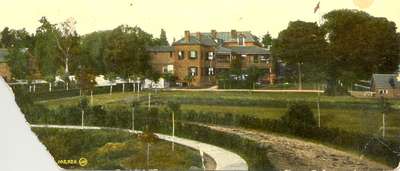Colonel William Chambliss, son-in-law of George Shoenberger, one of the wealthiest families in Pennsylvania, had moved to Cobourg in 1867 and saw the advantage of having a first class hotel for the American upper class to use as a summer retreat. The hotel reached its peak and for over 40 years it was the center of the summer colony. After WWI its popularity declined. The hotel closed in the late 1920s and after a small fire it was demolished in 1937. The Arlington Hotel opened in 1874 and its opening marked the beginning of the American Colony in Cobourg. It contained 150 rooms of which 120 were bedrooms with private parlours. These were located on the top three floors. On the ground floor was a dining room, bar, games room, parlour, commercial rooms and barber shop along with the kitchens. Cedarmere was on the lake shore at the foot of Love Lane (now Ontario Street). It was originally built by Arthur McBean, and later occupied by the Castle family. James Crowther, whose wife was the Castle's daughter, turned the home into a hotel, which was popular with both the Cobourg citizens and the American vacationers. Cedarmere was on the lake shore at the foot of Love Lane (now Ontario Street). It was originally built by Arthur McBean, and later occupied by the Castle family. James Crowther, whose wife was the Castle's daughter, turned the home into a hotel which was popular with both the Cobourg citizens and the American vacationers. Cedarmere Hotel and Grounds Details The Columbian had two annexes, Lake View Lawn and the Baltimore. On Lake View Lawn were two first-class cottages containing, in both cottages about thirty rooms. The Baltimore was near the lake and had about twenty-five excellent sleeping rooms. It was established in 1893 and demolished in 1994. The Columbian had two annexes, Lake View Lawn and the Baltimore. On Lake View Lawn were two first-class cottages containing, in both cottages about thirty rooms. The Baltimore was near the lake and had about twenty-five excellent sleeping rooms. It was established in 1893 and demolished in 1994. The center building (with the double doorway) and the one to the left (318, 320, 322, 324 Division St. N.)are part of a group of early frame buildings constructed for both commerical and domestic use. They range in date from 1840 to the mid 1850s. William Grieve built this particular set for John Fletcher, who then used the buildings as his shoe and boot store and his home. About 1884 Evor Leonard opened an R.S. McLaughlin carriage dealership on Division Street in downtown Cobourg. With the arrival of the motor car his shop became the first outlet in the Cobourg area to sell the McLaughlin buick. The carriage business operated into the 1930s. The Phoenix building takes up one town block - the whole east side of Division Street and about 100 feet of King Street. It is the longest and second largest commercial building in Cobourg. It was built 1881-82. Pre-1812 there were three communities existing in the area of what would later become Cobourg. Amherst, was the largest settlement and was located about a mile northwest of present-day Cobourg. Lewis Stiles acquired this corner property in 1817 and operated a hotel there for a number of years. The January 1861 Census for Cobourg lists John Field, gentleman, Congregationalist, age 65 with one horse and one carriage for pleasure, in a 1.5 story brick house and says "Just built a new hotel called "Taunton House" which is 3 stories high". This Ontario Gothic cottage was built by John Cullingford (local druggist) in 1856. He also conducted his business from this building. Located on this particular stretch of land were three very well known summer hotels, the Lakeview Terrace, the Columbian and the Arlington. When a proposal was put forth to build an apartment complex on the Lakeview site a group on concerned citizens raised most of the money so that the property could become public. This pressure finally resulted in town buying the land that the Lakeview was located on. 















